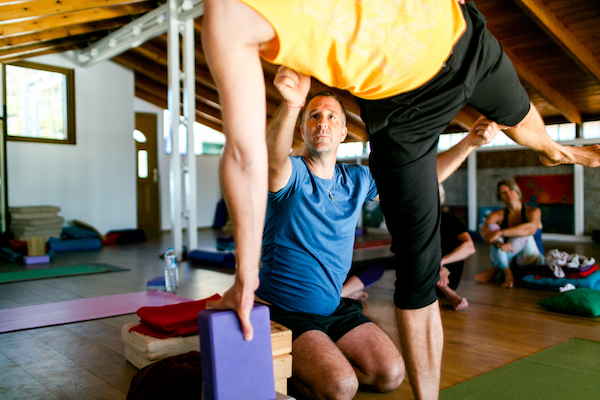Patanjali created the eight limbs of yoga known as ‘ashtanga’, ‘ashta’ meaning eight and ‘anga’ meaning limbs. These eight limbs are a pathway to living a yogic life, and the third limb is the practice of asana.
So often you hear this phrase, “Yoga will change your life!” So often your friends tell you that you should do yoga.
Sarah Anderson demonstrates this perfectly in this cartoon in Sarah’s Scribbles.

So what is it about this asana/yoga posture business that seems to have been changing everyone’s life?
The purpose of yoga postures and what happens when you master them!
Asana refers to the postures that we practice in yoga. The aim of which is to cultivate discipline and the ability to sit comfortably in meditation.
It is common when we hold postures for longer amounts of time that irritation arises, when we hold a posture we begin to go into our mind which causes a restlessness. However, this restlessness is only at the surface level of our mind. This is our lower mind and is concerned with basic thoughts such as eating, survival, agitation caused by relationships with others, even the grocery shopping list!
Once we are able to manage this restlessness and quieten the lower mind, the higher mind starts to shine and we can see what is stored within the depths of the lake of our mind, what is below the surface.

The lower mind is our conscious mind, all of the surface thoughts we think about throughout the day, whereas the higher mind is our unconscious mind, the vast reservoir below the surface and contains memories from when we were much younger and from our past lives.
Yoga should help you to thrive in your life, guiding you to step out of your own way and get on the path you are destined for – your dharma. Patanjali wrote the Yoga Sutra, a collection of sutras to provide a road map to achieving the eight limbs.
The sutras relating to asana are often widely misunderstood, there are variations of interpretation, conjecture, and sometimes they are twisted to serve self-interest.
Sutra 2.46 is extremely important and is the sutra that modern yoga studios are built on, it defines what asana is. The sutra says “sthira sukham asanam” and essentially means the postures of asana should be still, easy and this is your seat.
The number one reason people don’t meditate is because they do not know how to quieten their mind so feel pre-occupied and agitated. However, Patanjali has given us the tools to quieten our minds.

Sthira
Sthira is often translated as strength which is incorrect, and can be used as a justification of some of the stronger more acrobatic postures. In truth sthira is about becoming completely still, it is the practice of being steady, stable and motionless.
Becoming still and steady is not easy, but when we still the body the mind begins to settle and quieten. You may notice when the mind quietens that old memories surface, ideas may come, dreams or things you haven’t thought about for a long time. This is because the mind is processing, something we don’t usually give ourselves time to do in our daily lives.
We need time to sit in stillness so that we can contemplate and think about things on a deeper level. This is a process we used to be good at doing, sitting on the porch, talking with people face to face, digesting our thoughts. However with the influence of modern technology and social media this tends not to happen as we are in a constant state of distraction and agitation.
Sukham
The translation of sukham is ‘good space’, this means there is nothing disturbing you in your space, no desire for something that is going to happen in the future, not worrying about the past, no distractions, not waiting for the meditation to end.
You are comfortable, filled with ease, an effortless place of deep inner peace and joy.
This could mean you only give 60% instead of 100% in your asana practice to make it effortless and find that ease and joy.

Asanam
Usually translated to mean pose or posture the word asanam actually comes from the root ‘as’ which means to sit. It is the posture of sitting in meditation, therefore asana by definition means seat.
In summary, sutra 2.46 tells us we need to get still, with a quality of effortlessness, and this is our seat.
Sutra 2.48 is the promise of what will happen when you practice if you truly practice in accordance with the sutras. This sutra says “tatah dvandva anabhighata” and translates to mean that pairs of opposites cease to have any effect or impact.
Tatah – Then, from that
Dvandva – Pairs of opposites, dualities
Anabhighata – Freedom from suffering, without effect or impact
Our mind is constantly chasing after pleasure and trying to avoid pain, pleasure and pain being an example of pairs of opposites. We take extreme measures to avoid discomfort when actually we should sit with discomfort. We do not have to sit with it forever, but when something arises that causes discomfort we should take time to come to a place of stillness and sit with it, this is of itself a practice of asana.
We have been conditioned to immediately react to things, and sometimes even react in a certain manner because of our social conditioning or a belief that is how other people think we should react. By sitting with things we teach ourselves not to be so reactionary, and seek to understand before reacting.
By attaining this posture of stillness and effortlessness there is a freedom from suffering as we are no longer disturbed. In the truest sense of the word, we are balanced, approaching everything with equanimity and equilibrium.
You really can change your life profoundly by creating moments of stillness, finding joy and ease.

Want to learn more about the power of yoga? Join Yogi Aaron for a Yoga Teacher Training!
All photos credited to the talented Maria Hillier.

